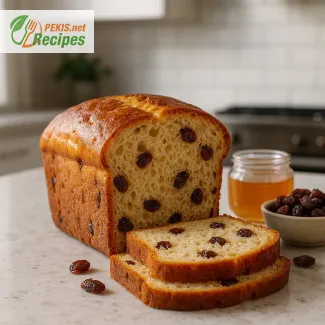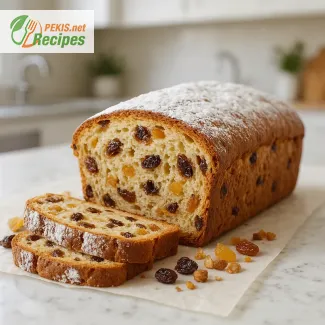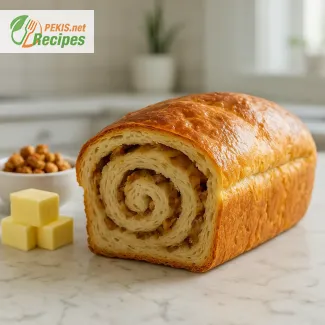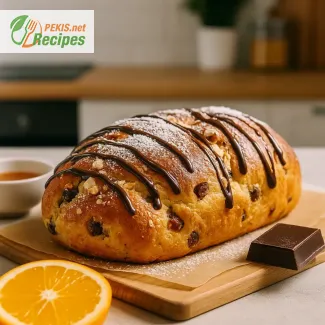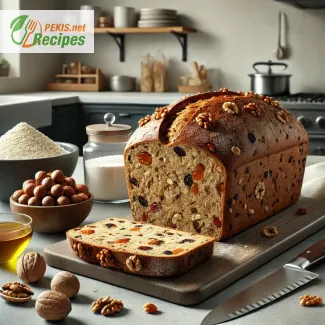Fermented Bahn with Asian Flavors serves 4 portions with a 30-minute prep time, 20-minute bake time, and a total of 50 minutes. The dough combines all-purpose flour, natural starter, and aromatic touches of ginger, garlic, and sesame oil, creating a bread that is soft inside with a lightly crisp crust. Its fermented character brings depth and digestibility, pairing perfectly with pickled vegetables, tofu, or grilled meats. The bread stays fresh for 2 days at room temperature, can be frozen for 2 months, and reheats at 150 °C for 8–10 minutes. The result is a versatile, flavorful base that blends Asian culinary tradition with modern creativity.
PEKIS – professional chef and recipe developer with more than 25 years of experience, specialized in European and international cuisine. With countless hours spent mastering fermentation techniques and exploring Asian flavors, I’ve refined this Bahn recipe to highlight both tradition and creativity in a way that feels authentic yet approachable for any kitchen.

Exploring the Art of Fermented Bahn with Asian Flair
A journey through taste, culture, and modern creativity
The unique appeal of fermented Bahn lies in its perfect balance of Asian flavors and the subtle complexity that fermentation brings to every bite. Unlike ordinary bread or flatbreads, this version embraces the depth of tangy notes developed naturally during the fermentation process. Each piece carries layers of flavor, ranging from mild sourness to delicate umami, making it a remarkable centerpiece for both everyday meals and festive gatherings. The texture is soft yet resilient, ideal for holding vibrant fillings or serving alongside richly seasoned dishes.
Origin and cultural background
The history of Bahn is deeply rooted in Southeast Asia, where traditional fermentation techniques have been celebrated for centuries. This approach to bread making evolved as a way to preserve dough and enhance its digestibility. Over time, it became more than preservation—it transformed into a method of flavor enrichment. The naturally leavened dough carries cultural significance, representing patience, transformation, and the timeless connection between food and community. Today, the trend of fermentation has spread globally, and Bahn has found its place in modern kitchens, where traditional knowledge meets contemporary creativity.
Key characteristics of fermented Bahn
- Flavor development: Fermentation brings a gentle tang and a depth that cannot be replicated with quick-rise methods.
- Texture contrast: The balance of airy crumb and slightly chewy bite makes it versatile for different culinary uses.
- Health benefits: Naturally fermented dough often feels lighter and easier to digest.
- Pairing flexibility: Works beautifully with savory Asian marinades, spicy pickles, or even sweet toppings.
Why you will love this recipe
- Simple process with rewarding results.
- Combines traditional Asian flavors with a modern twist.
- Creates a bread that is both unique and comforting.
- Flexible enough to pair with a wide range of fillings and toppings.
- Showcases the rising trend of fermentation in home cooking.
Storage and make-ahead tips
Fermented Bahn keeps well at room temperature for up to 2 days when wrapped in a clean cloth or stored in a bread box. For longer storage, freeze portions for up to 2 months in airtight containers. To reheat, warm in an oven at 150 °C for 8–10 minutes until revived and aromatic. This makes it convenient for busy schedules and ensures that freshly baked taste is always within reach.
Creative variations and serving ideas
- Herb infusion: Add finely chopped lemongrass, cilantro, or Thai basil into the dough for a fragrant finish.
- Spiced Bahn: Blend in warming spices like star anise, coriander seeds, or turmeric to highlight the Asian character.
- Stuffed version: Fill the dough with sautéed mushrooms, marinated tofu, or minced chicken for a heartier option.
- Sweet twist: Incorporate coconut milk or palm sugar for a subtle dessert-style Bahn.
- Fusion Bahn: Pair with Mediterranean fillings like roasted vegetables and tahini, creating a cross-cultural experience.
Semantic insights into flavor and pairing
The fermentation process acts as the soul of Bahn, creating lactic acid that delivers complexity, while the starch breakdown produces natural sweetness. These chemical changes enhance the harmony between the dough and Asian-inspired fillings such as kimchi, pickled radish, or spicy chili oils. The bread becomes more than just a carrier; it integrates itself into the flavor story, turning simple meals into multi-dimensional culinary experiences.
How ingredients shape the final result
- Flour determines the structure and chewiness, with high-protein varieties giving strength to the dough.
- Water influences hydration, which affects both the texture and the openness of the crumb.
- Fermentation starter (natural yeast or pre-ferment) is the heart of flavor, driving complexity.
- Salt regulates fermentation speed and balances taste.
- Optional aromatics like sesame oil or ginger accentuate the Asian taste profile.
The modern appeal of fermented Bahn
In today’s kitchens, fermented Bahn reflects a growing desire to reconnect with ancient culinary wisdom while experimenting with new flavors. The slow rise and careful balance of ingredients encourage mindfulness in cooking, while the adaptable base makes it a favorite for creative chefs and home cooks alike. Whether served alongside traditional Asian stews, packed with colorful vegetables, or enjoyed plain with a drizzle of sesame oil, this bread represents the best of tradition meeting innovation.
- In a large bowl, combine the flour and water. Mix until no dry spots remain, then let the mixture rest for 30 minutes to allow for natural hydration.
- Add the natural starter, salt, sugar, sesame oil, grated ginger, and minced garlic. Mix thoroughly until the dough becomes smooth.
- Knead the dough for 10 minutes until elastic and slightly glossy.
- Place the dough in a lightly oiled bowl, cover, and let it ferment at room temperature for 4–6 hours, or until doubled in size.
- Gently deflate the dough, fold it, and let it rest again for 1 hour to strengthen its structure.
- Shape the dough into small, flat rounds suitable for Bahn. Place on a parchment-lined baking sheet.
- Let the shaped pieces rise for 1 hour.
- Bake in a preheated oven at 200 °C (390 °F) for 18–20 minutes until golden brown and slightly crispy on the outside.
- Allow to cool for 10 minutes before serving with Asian-inspired fillings such as pickled vegetables, marinated tofu, or grilled meats.
FAQ questionWhat is fermented Bahn?
Fermented Bahn is a soft, lightly crisp flatbread made with a natural starter that develops gentle tang, aroma, and a tender crumb. The slow rise builds flavor complexity and improves dough handling, giving you a bread that pairs beautifully with Asian flavors like sesame, ginger, and pickles.
FAQ questionCan I use instant yeast instead of a natural starter?
Yes, but expect a milder flavor. Use 7 g (1 packet) instant yeast and reduce bulk fermentation to 1–2 hours. To boost depth, add a small preferment (equal parts flour and water with a pinch of yeast) and let it stand 6–8 hours before mixing the final dough.
FAQ questionHow tangy should it taste?
Aim for a gentle tang, not sour. If it’s too sharp, your dough likely over‑fermented. Next time, shorten bulk fermentation, keep dough between 22–24 °C, and add salt on time to moderate activity.
FAQ questionWhich flour works best?
Medium‑ to high‑protein all‑purpose flour (around 11–12% protein) gives a supple, resilient dough. A 10–20% blend of whole wheat adds nuttiness; a small portion of rice flour can improve tenderness while keeping the crumb light.
FAQ questionWhat hydration should I target?
With 500 g flour and 300 ml water plus starter, you’re near 60–65% effective hydration (depending on starter hydration). The dough should feel soft, slightly tacky, and smooth after kneading and rest.
FAQ questionHow warm should the dough be during fermentation?
Keep dough at 22–24 °C for balanced fermentation. Warmer than 26 °C speeds activity and risks over‑proofing; cooler than 20 °C slows rise and flavor development. Cover to prevent drying.
FAQ questionHow do I shape for even browning?
Divide and pre‑shape into tight balls, rest 10–15 minutes, then press into even discs about 1–1.5 cm thick. Lightly oil the surface to encourage uniform color and prevent sticking. Avoid degassing aggressively—retain gas bubbles for tenderness.
FAQ questionOven, skillet, or Air Fryer?
- Oven: 200 °C for 18–20 minutes for golden tops and a steady bake.
- Cast‑iron skillet: Medium heat, 3–4 minutes per side; finish in a 180 °C oven for 5 minutes if needed.
- Air Fryer: 180 °C for 8–10 minutes, flipping halfway; brush lightly with oil for a crisp edge.
FAQ questionWhat fillings go best with the Asian flavor profile?
Try pickled vegetables, marinated tofu, grilled chicken with ginger‑garlic, or a swipe of sesame oil and chili crisp. The bread’s mild tang enhances umami from soy sauce, miso, or gochujang without overpowering fresh herbs like coriander.
FAQ questionHow do I store and reheat?
Keep at room temperature for 2 days (wrapped or in a bread box). Freeze up to 2 months in airtight bags. Reheat at 150 °C for 8–10 minutes (or 3–4 minutes in a warm skillet) to restore soft crumb and light crispness.
FAQ questionHow can I make it gluten‑free?
Use a gluten‑free blend (rice flour + tapioca starch + a binder like psyllium). Hydration may need a slight increase; rest the dough longer to hydrate fully. Flavor lifts from ginger, garlic, and sesame oil help mimic the depth of wheat fermentation.
FAQ questionWhy is my bread dense or flat?
Common causes include under‑proofing, overly tight shaping, or flour with too little protein. Ensure the dough doubles during bulk, handle gently to preserve gas, and maintain fermentation temperature. If over‑proofed (very slack, sour), shorten the rise and cool the environment.
Fermented Bahn brings together tradition and innovation in a way that feels timeless yet modern. The slow rise of the dough, combined with the natural starter, creates an experience that is not only flavorful but also deeply connected to centuries of culinary practice. Every bite reflects the gentle tang of fermentation, the warmth of ginger and garlic, and the richness of sesame oil, forming a bread that stands apart from ordinary flatbreads.
The appeal of this Bahn lies in its versatility. It fits seamlessly into both casual meals and festive occasions, pairing with simple spreads, fresh herbs, or bold Asian fillings. Its soft interior and golden crust offer comfort, while its subtle complexity invites creativity in every serving. Whether paired with vegetables, proteins, or even sweet twists, it adapts to your table without losing its unique character.
A strong part of its charm is the way it encourages mindful cooking. The process cannot be rushed, and that patience rewards you with a bread that feels alive. Preparing and sharing it connects people across cultures, reinforcing the universal role of bread as a food of community and care.
With its balance of flavor, texture, and aroma, fermented Bahn is more than just a base for toppings. It’s an exploration of heritage, a celebration of Asian flavors, and an invitation to bring the art of fermentation into everyday life. This recipe carries a story in every step, and its result is a bread that feels as nourishing to the spirit as it is satisfying to the taste.
Allergens present in the recipe:
- Gluten (from flour)
- Possible traces of sesame (from sesame oil)
Substitution tips for allergens and gluten:
- Replace wheat flour with a gluten-free flour blend (e.g., rice flour and tapioca starch).
- Replace sesame oil with olive oil or sunflower oil for those allergic to sesame.
- Vitamin B1 (Thiamine): 0.25 mg – supports energy metabolism
- Vitamin B2 (Riboflavin): 0.15 mg – contributes to normal skin and vision
- Vitamin B3 (Niacin): 3.2 mg – supports the nervous system
- Vitamin B6: 0.2 mg – helps in protein metabolism
- Folate: 55 µg – important for red blood cell formation
- Iron: 3.1 mg – contributes to oxygen transport in the body
- Magnesium: 28 mg – supports muscle function
- Zinc: 1.2 mg – strengthens immune response
- Polyphenols: 45 mg – protect cells from oxidative stress
- Selenium: 7 µg – supports immune defense and thyroid health
- Flavonoids from coriander: 20 mg – anti-inflammatory effects
- Gingerol from ginger: 15 mg – improves circulation and reduces inflammation
